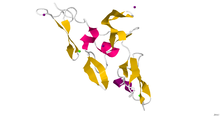Effects of the storage conditions on the stability of natural and synthetic cannabis in biological matrices for forensic toxicology analysis: An update from the literature
Contents
| fibrillin 1 | |||||||
|---|---|---|---|---|---|---|---|
 Crystallographic structure of the cbEGF9-hybrid2-cbEGF10 region of human fibrillin 1.[1] | |||||||
| Identifiers | |||||||
| Symbol | FBN1 | ||||||
| Alt. symbols | FBN, MFS1, WMS | ||||||
| NCBI gene | 2200 | ||||||
| HGNC | 3603 | ||||||
| OMIM | 134797 | ||||||
| PDB | 2W86 | ||||||
| RefSeq | NM_000138 | ||||||
| UniProt | P35555 | ||||||
| Other data | |||||||
| Locus | Chr. 15 q21.1 | ||||||
| |||||||
| fibrillin 2 | |||||||
|---|---|---|---|---|---|---|---|
| Identifiers | |||||||
| Symbol | FBN2 | ||||||
| Alt. symbols | CCA | ||||||
| NCBI gene | 2201 | ||||||
| HGNC | 3604 | ||||||
| OMIM | 121050 | ||||||
| RefSeq | NM_001999 | ||||||
| UniProt | P35556 | ||||||
| Other data | |||||||
| Locus | Chr. 5 q23-q31 | ||||||
| |||||||
| fibrillin 3 | |||||||
|---|---|---|---|---|---|---|---|
| Identifiers | |||||||
| Symbol | FBN3 | ||||||
| NCBI gene | 84467 | ||||||
| HGNC | 18794 | ||||||
| OMIM | 608529 | ||||||
| RefSeq | NM_032447 | ||||||
| UniProt | Q75N90 | ||||||
| Other data | |||||||
| Locus | Chr. 19 p13 | ||||||
| |||||||
Fibrillin is a glycoprotein, which is essential for the formation of elastic fibers found in connective tissue.[2] Fibrillin is secreted into the extracellular matrix by fibroblasts and becomes incorporated into the insoluble microfibrils, which appear to provide a scaffold for deposition of elastin.[3]
Clinical aspect
Mutations in FBN1 and FBN2 are associated with Template:SWL.[4]
Types
Fibrillin-1
Fibrillin-1 is a major component of the microfibrils that form a sheath surrounding the amorphous elastin. It is believed that the microfibrils are composed of end-to-end polymers of fibrillin. To date, 3 forms of fibrillin have been described. The fibrillin-1 protein was isolated by Engvall in 1986,[5] and mutations in the FBN1 gene cause Marfan syndrome.[6]
This protein is found in humans, and its genes are found on chromosome 15. At present more than 600 different mutations have been described.[1]
Structure
There is no complete, high-resolution structure of fibrillin-1. Instead, short fragments have been produced recombinantly and their structures solved by X-ray crystallography or using NMR spectroscopy. A recent example is the structure of the fibrillin-1 hybrid2 domain, in context of its flanking calcium binding epidermal growth factor domains, which was determined using X-ray crystallography to a resolution of 1.8 Å.[1] The microfibrils that are made up of fibrillin protein are responsible for different cell-matrix interactions in the human body.
Fibrillin-2
Fibrillin-2 was isolated in 1994 by Zhang[7] and is thought to play a role in early elastogenesis. Mutations in the fibrillin-2 gene have been linked to Beal's Syndrome.
Fibrillin-3
More recently, fibrillin-3 was described and is believed to be located mainly in the brain.[8] Along with the brain, fibrillin-3 has been localized in the gonads and ovaries of field mice.
Fibrillin-4
Fibrillin-4 has only very recently been discovered in zebrafish, and has a sequence similar to fibrillin-2.[9]
References
- ^ a b c PDB: 2W86; Jensen SA, Iqbal S, Lowe ED, Redfield C, Handford PA (May 2009). "Structure and interdomain interactions of a hybrid domain: a disulphide-rich module of the fibrillin/LTBP superfamily of matrix proteins". Structure. 17 (5): 759–68. doi:10.1016/j.str.2009.03.014. PMC 2724076. PMID 19446531.
{{cite journal}}: CS1 maint: multiple names: authors list (link) - ^ Kielty CM, Baldock C, Lee D, Rock MJ, Ashworth JL, Shuttleworth CA (February 2002). "Fibrillin: from microfibril assembly to biomechanical function". Philos. Trans. R. Soc. Lond., B, Biol. Sci. 357 (1418): 207–17. doi:10.1098/rstb.2001.1029. PMC 1692929. PMID 11911778.
{{cite journal}}: CS1 maint: multiple names: authors list (link) - ^ Singh (2006). Textbook of human histology. Jaypee Brothers Publishers. pp. 64–. ISBN 978-81-8061-809-3. Retrieved 9 December 2010.
- ^ Attention: This template ({{cite pmid}}) is deprecated. To cite the publication identified by PMID 24833718, please use {{cite journal}} with
|pmid=24833718instead. - ^ Sakai LY, Keene DR, Engvall E (December 1986). "Fibrillin, a new 350-kD glycoprotein, is a component of extracellular microfibrils". J. Cell Biol. 103 (6 Pt 1): 2499–509. doi:10.1083/jcb.103.6.2499. PMC 2114568. PMID 3536967.
{{cite journal}}: CS1 maint: multiple names: authors list (link) - ^ Dietz HC; Guttmacher, Alan E.; Dietz, Harry C. (August 2010). "New therapeutic approaches to mendelian disorders". N. Engl. J. Med. 363 (9): 852–63. doi:10.1056/NEJMra0907180. PMID 20818846.
- ^ Zhang H, Apfelroth SD, Hu W; et al. (1994). "Structure and expression of fibrillin-2, a novel microfibrillar component preferentially located in elastic matrices". J. Cell Biol. 124 (5): 855–63. doi:10.1083/jcb.124.5.855. PMC 2119952. PMID 8120105.
{{cite journal}}: Explicit use of et al. in:|author=(help)CS1 maint: multiple names: authors list (link) - ^ Corson GM, Charbonneau NL, Keene DR, Sakai LY (March 2004). "Differential expression of fibrillin-3 adds to microfibril variety in human and avian, but not rodent, connective tissues". Genomics. 83 (3): 461–72. doi:10.1016/j.ygeno.2003.08.023. PMID 14962672.
{{cite journal}}: CS1 maint: multiple names: authors list (link) - ^ Gansner JM, Madsen EC, Mecham RP, Gitlin JD (October 2008). "Essential role for fibrillin-2 in zebrafish notochord and vascular morphogenesis". Dev. Dyn. 237 (10): 2844–61. doi:10.1002/dvdy.21705. PMC 3081706. PMID 18816837.
{{cite journal}}: CS1 maint: multiple names: authors list (link)
External links
- Fibrillin at the U.S. National Library of Medicine Medical Subject Headings (MeSH)













